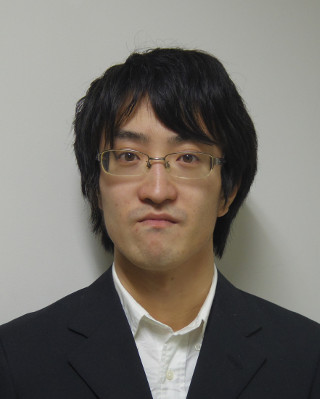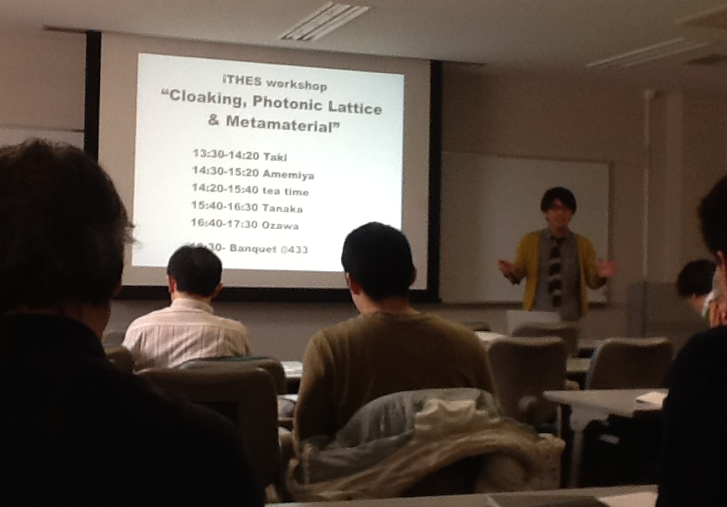|
|
|
|
Minister of MEXT commends Tetsuo Hatsuda
As a part of the annual Commendation for Science and Technology by the Minister of Education, Culture, Sports, Science and Technology (MEXT), Prize for Science and Technology was awarded to Dr. Tetsuo Hatsuda, the group director of iTHES, along with two his collaborators, Prof. Shinya Aoki from Yukawa Institute of Kyoto University and Prof. Noriyoshi Ishii from Univ. of Tsukuba. The awards ceremony took place on April 15th 2014 at MEXT auditorium:
http://www.riken.jp/pr/topics/2014/20140415_2/
Dr. Franco Nori, the team leader of iTHES-cond team, has received this Prize in 2013:
http://www.riken.jp/en/pr/topics/2013/20130416_1/
Congratulations to both Franco and Tetsuo!
|
|
|
Upcoming Events
|
|
iTHES Lecture (in Japanese)
Date: 13:30〜17:00, April 23 (Wed), 2014
Place: RIKEN Main Research Building 4F, 435-437
Speaker: Prof. Shigeru Shinomoto (Kyoto Univ.)
iTHES Seminar
Date: 13:30〜15:00, April 24 (Thu.), 2014
Place: RIKEN Main Research Building 4F, 433
Speaker: Prof. Shigeru Shinomoto (Kyoto Univ.)
Title: Reading neuronal spike trains
iTHES-IPMU-Osaka Joint Symposium,
Nov. 12 (Wed.) 2014
at Kavli IPMU, Univ. Tokyo (http://www.ipmu.jp/ )
|
|
|
Event report
About 30 people gathered for the iTHES workshop “cloaking, photonic lattice and metamaterial” held on 14 April 2014. The workshop was aimed at promoting cross-cutting discussions in research fields such as invisibility cloaking, photonic lattice and metamaterial.
Taki gave a review on basics of the theory of invisibility cloaking
and explained his recent collaboration with T.Amemiya on an extended cloaking device. Dr. Amemiya explained how to fabricate and make use of metamaterial for invisibility cloaking. He also talked about experimental aspects of the extended cloaking device. Prof. Tanaka gave a lecture on recent progress in metamaterial for radiant rays, 3d metamaterial and self-organizing metamaterial. Dr. Ozawa introduced a photonic lattice version of the quantum Hall effect, and then he explained the importance of the role played by topological nature of the Berry phase in photonic systems.
|
|
|
Person of the Week
Kazuki Maeda
Self-introduction
I am Kazuki Maeda, a new iTHES postdoc researcher. I received Ph.D. in informatics
from Kyoto University in this March, and joined Theoretical Biology Laboratory in
this April. At the university, I had been studying applied mathematics, especially
the theory of discrete integrable systems (discretized soliton equations, e.g.
discrete KdV equation, discrete Toda lattice, ...) and its applications to
matrix eigenvalue algorithms. In the last two decades, ultradiscrete integrable systems,
which are cellular automata having soliton solutions, have attracted much attention.
A typical example is the box-ball system, which has binary soliton solutions.
I also studied a relationship among the box-ball system, the discrete Toda lattice
and an eigenvalue algorithm. Then, I found an interesting correspondence between
the box-ball system and the eigenvalue algorithm.
In RIKEN, there are many physicists, chemists, biologists, and engineers.
But there seems to be not so many mathematicians. The iTHES project is trying to solve
interdisciplinary challenging problems in theoretical science. I would be pleased
if I could contribute to the project from the mathematical viewpoint.
|
|
|
|
|
|

